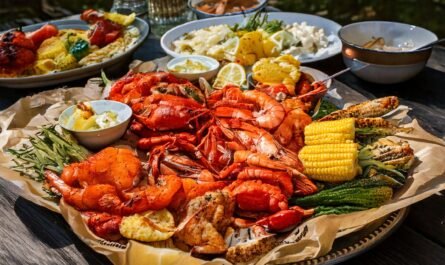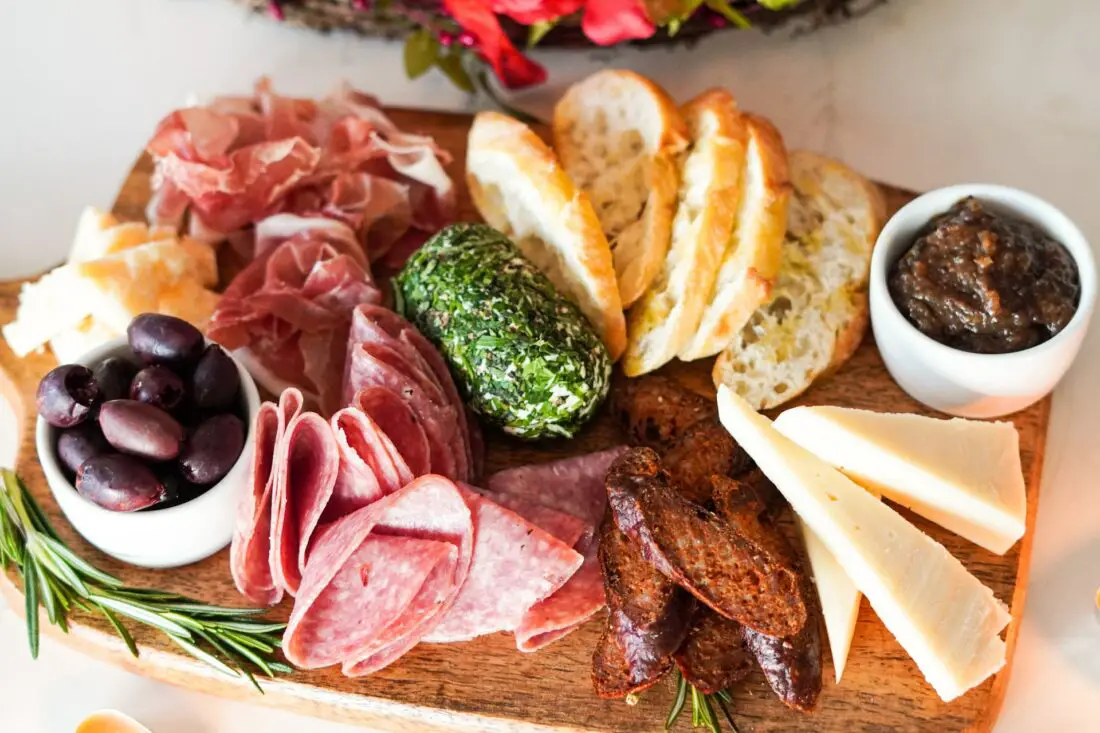For a certain generation in Michigan and around the Great Lakes, the road trip menu was once simple. You saw the orange roof, the teal roof, or the cartoon cowboy and you knew exactly what lunch would taste like. Many of those places are now gone, having been folded into larger brands, stripped for real estate, or demolished due to poor corporate decisions.
Yet here’s the twist: some of the food — and even a few of the brands — outlived the restaurants themselves. That’s the odd part of this story. A chain can be dead in the ground, while its chocolate cake or pecan log roll is still quietly making money in the freezer aisle.
Table of Contents
Defunct Michigan Restaurants
This look back at defunct Michigan restaurants, and a few close cousins, is less about corporate obituaries and more about what they meant to Midwest families who grew up along I-75, US-23, and M-10.
Dog n Suds: The Last Nostalgic Great Lakes Drive-In
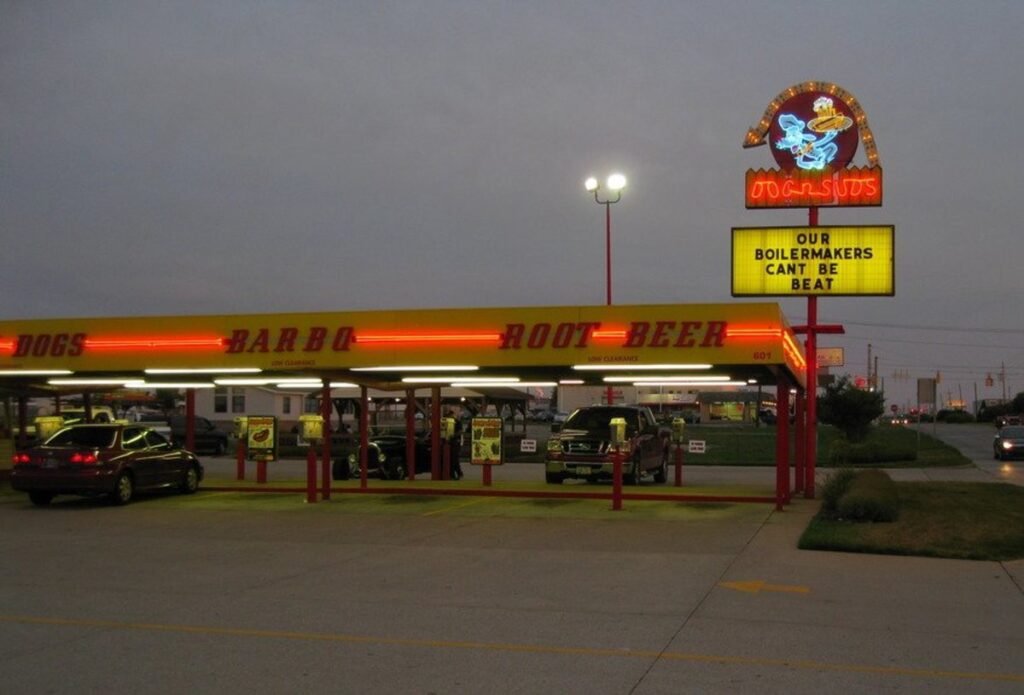
In the 1950s and 1960s, Dog n Suds was the summer soundtrack of small resort towns around the Great Lakes. Two music teachers launched the chain in Champaign, Illinois, in 1953. Within 15 years, there were more than 650 locations, many scattered through Michigan, Indiana, and neighboring states, slinging coney dogs, burgers, and root beer to tourists and locals.
The butterfly roof, neon sign, and carhop tray hooked into your window were as much a part of vacation as the lake itself. Today, the story is slimmer. The company’s own site shows only one Dog n Suds left in Michigan, in Montague north of Muskegon, plus a handful of stands in Indiana, Illinois, and Ohio.
For people who grew up on these nostalgic Great Lakes drive-ins, the food mattered, but the ritual mattered more: pulling in on a humid night, headlights pointed at the menu board, hoping the root beer would come in a frosted mug, not a paper cup.
Bill Knapp’s: Closed Midwest Family Restaurant, Cake Still Standing
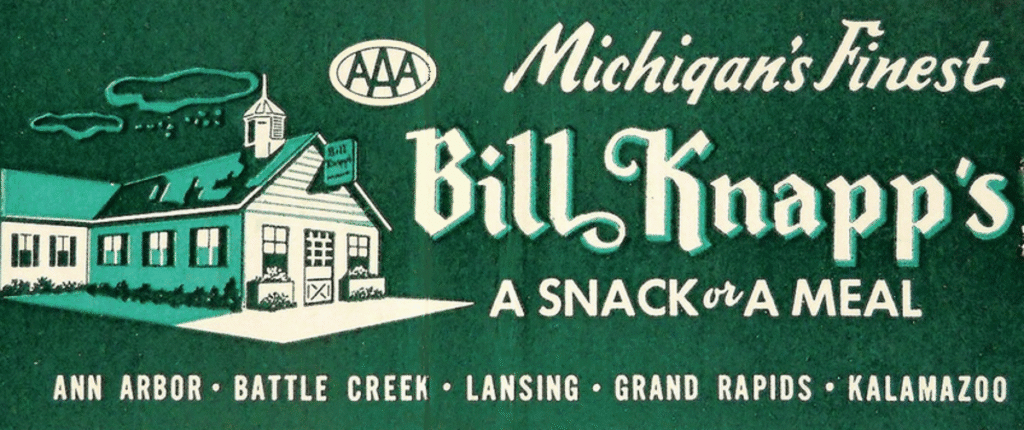
Bill Knapp’s started in Battle Creek in 1948 and built its name on made-from-scratch home cooking, senior discounts, and a birthday club that turned many Michiganders into regulars. At its peak, this chain of closed Midwest family restaurants ran about 60 locations across the region, usually parked near freeway exits so families could meet halfway between towns.
In the late 1990s, new owners tried to “modernize” the brand. They revamped the menu, brightened the interiors, and chased a younger crowd. The move backfired. Older, loyal diners hated the changes, traffic fell, and the chain never recovered. The last restaurant closed in 2002.
Here’s the counterintuitive insight: if you search what happened to Bill Knapp’s cake, you’ll find the brand never really left the store shelf. The famous chocolate cake was actually produced by Awrey’s, a longtime Michigan bakery. After the restaurants died, Awrey’s and a successor company kept the Bill Knapp’s name alive on frozen cakes and donuts. Those products are now sold in major grocery chains like Meijer and Kroger and through branded bakery outlets in places like Grand Rapids and Ann Arbor, with distribution in roughly 30 states.
So the restaurant is gone, but the cake — and the logo — still bring in revenue. Nostalgia got packaged, bar-coded, and parked in the freezer aisle.
Burger Chef: The Kids’ Meal Before the Happy Meal
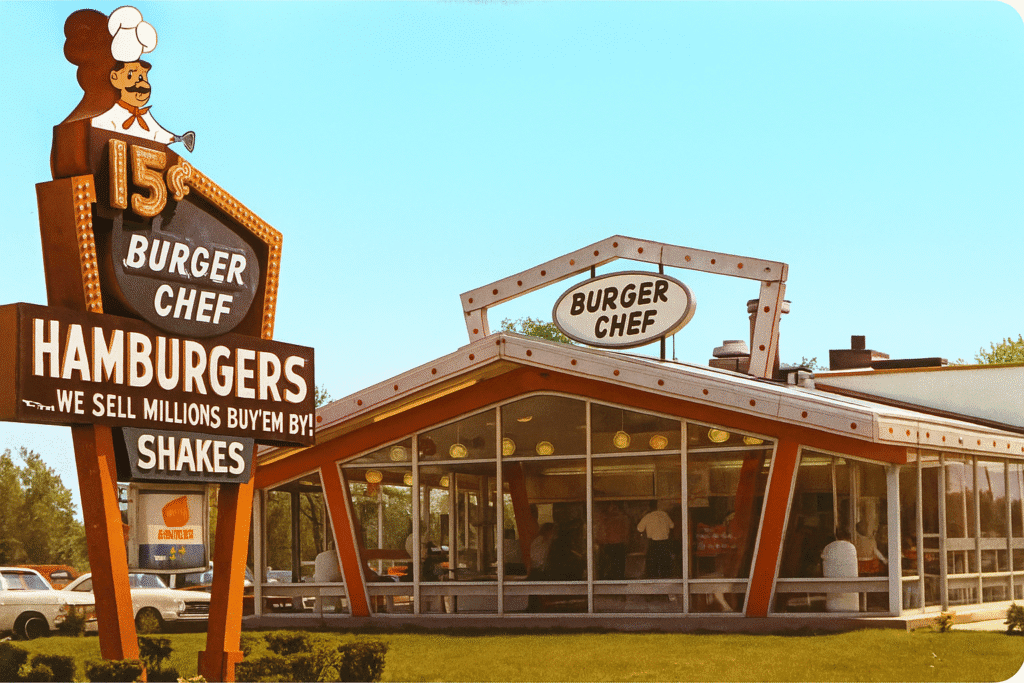
Founded in Indianapolis in 1954, Burger Chef grew from a regional burger joint into a 1,000-plus location chain by the early 1970s, with plenty of stores in Michigan. It built its brand on charbroiled burgers, pitched under names like Big Shef and Super Shef, and a distinctive, angular building design you could spot from the road.
The chain’s real innovation, though, was marketing to children. Burger Chef rolled out a bundled kids’ meal — including a toy — years before McDonald’s made the Happy Meal a global habit. That idea was copied so thoroughly that most people now assume it started with the Golden Arches.
After several ownership changes and a sale to General Foods, most Burger Chef locations were converted to Hardee’s. The last ones closed in the 1990s. The restaurant is gone, but if your parents grew up in Michigan in the 1960s and 1970s, Burger Chef and Jeff probably still live somewhere in their memory bank.
Farrell’s Ice Cream Parlour: Sugar Shock as a Business Model

Farrell’s didn’t start in the Midwest — its first shop opened in Portland, Oregon, in 1963 — but the chain spread quickly across Michigan and the Great Lakes region.
Farrell’s specialized in chaos. Staff in striped vests and straw hats banged drums, blew whistles, and paraded giant sundaes like “The Zoo” through the dining room. Kids’ birthdays turned into full-volume events. Parents either loved it or dreaded it.
By the mid-1970s, there were about 120 Farrell’s locations nationwide. Then sales dropped, and most parlors closed during the 1980s. The brand had a short-lived revival in California, but the final store in Brea shut down in 2019, officially turning Farrell’s into a memory.
If you grew up near one of the Michigan locations, the thought of the Pig Trough — a huge banana split served in a farm-style dish — still makes your teeth ache.
Champs: Waterford’s Burger Stop That Lived on Local Myth
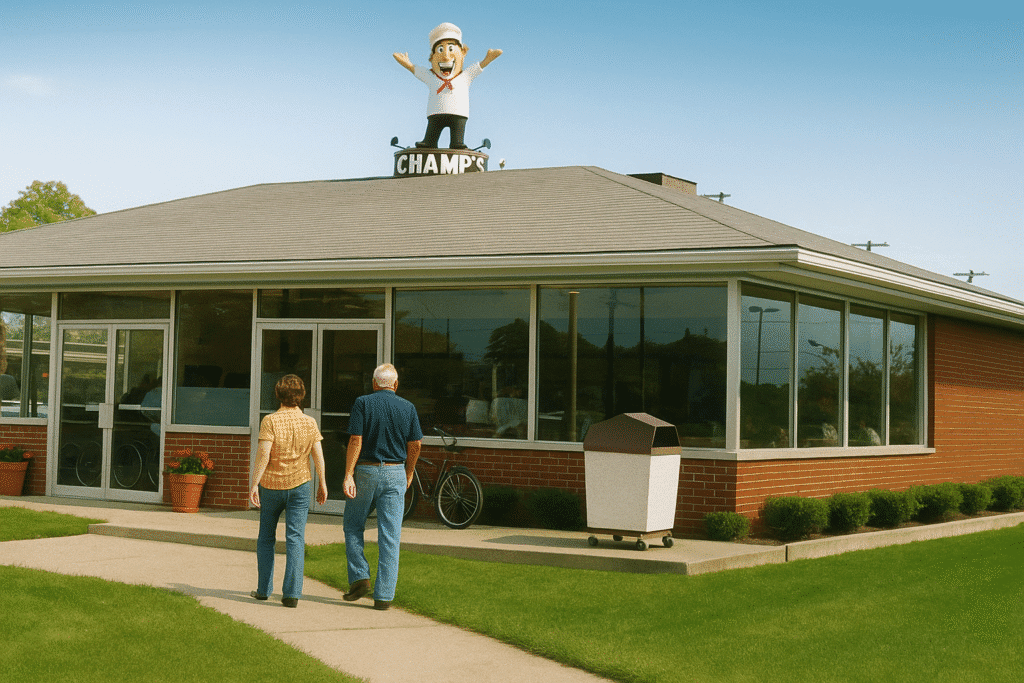
Not every loss is a national chain. Champs Hamburgers was a small local chain around Oakland County, including two stands in Waterford: one on M-59 and one at Dixie Highway and Andersonville Road.
Locals remember absurdly cheap burgers — stories mention 18-cent hamburgers when it opened — and a drive-up culture where kids would cruise the lot, showing off cars and stereos. The Dixie Highway stand sat by a branch of the Clinton River; teens brag about steering small boats right up to the back and ordering food like it was a marina snack bar.
The building didn’t vanish. One former location now houses another restaurant, and old photos still circulate in local history groups. Champs proves that not every beloved place needs a national footprint. Sometimes two buildings and a pile of memories are enough.
Sveden House Smorgasbord: All-You-Can-Eat Before the Mega Buffet
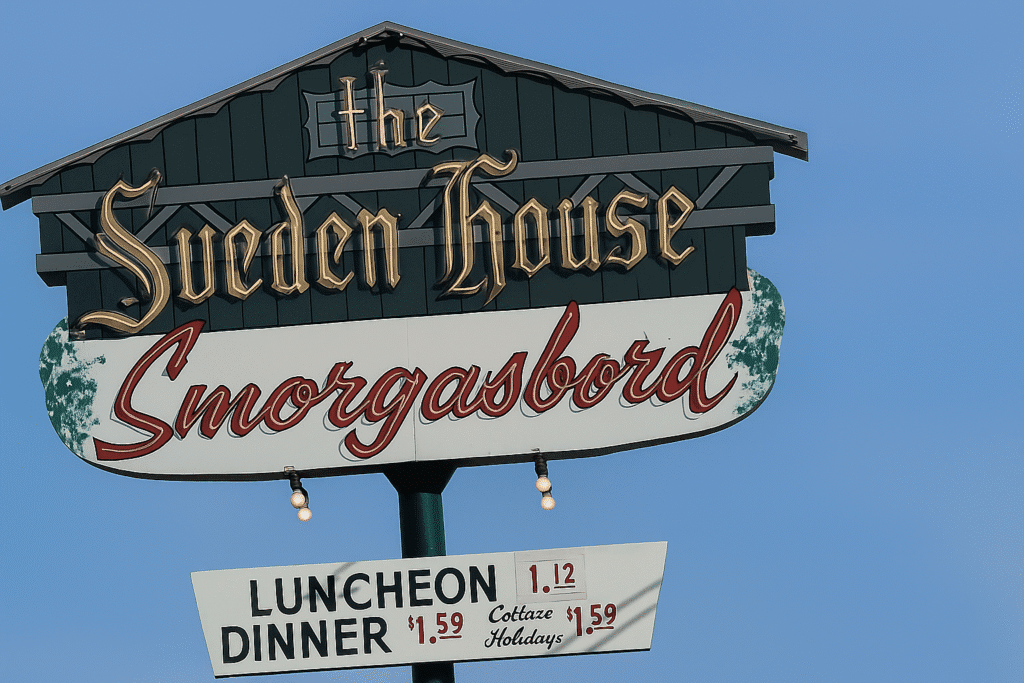
Sveden House Smorgasbord started in Duluth, Minnesota, and spread into Michigan cities like Grand Rapids, Lansing, Saginaw, and Bay City.
The pitch was simple: a budget-friendly buffet with carved roast beef, chicken, Swedish meatballs, apple fritters, bread pudding, carrot-raisin salad, and a sweet rice dish with marshmallows and cherries. Early on, chicken wings were a quiet star on the line before they became sports-bar currency.
The Scandinavian theme — flags on the wall, staff uniforms styled like “Swedish maids” — would raise eyebrows today. But for many Michigan teenagers, Sveden House was a first job. By the 1990s and 2000s, shifting tastes, new buffet competitors, and rising costs pushed the chain out of business.
People still argue about whether it was actually good food or just lots of food. Either way, Sveden House taught a generation how to time their second trip to the carving station.
Texan Family Restaurant: 3 a.m. Eggs in the Saginaw Bay Region
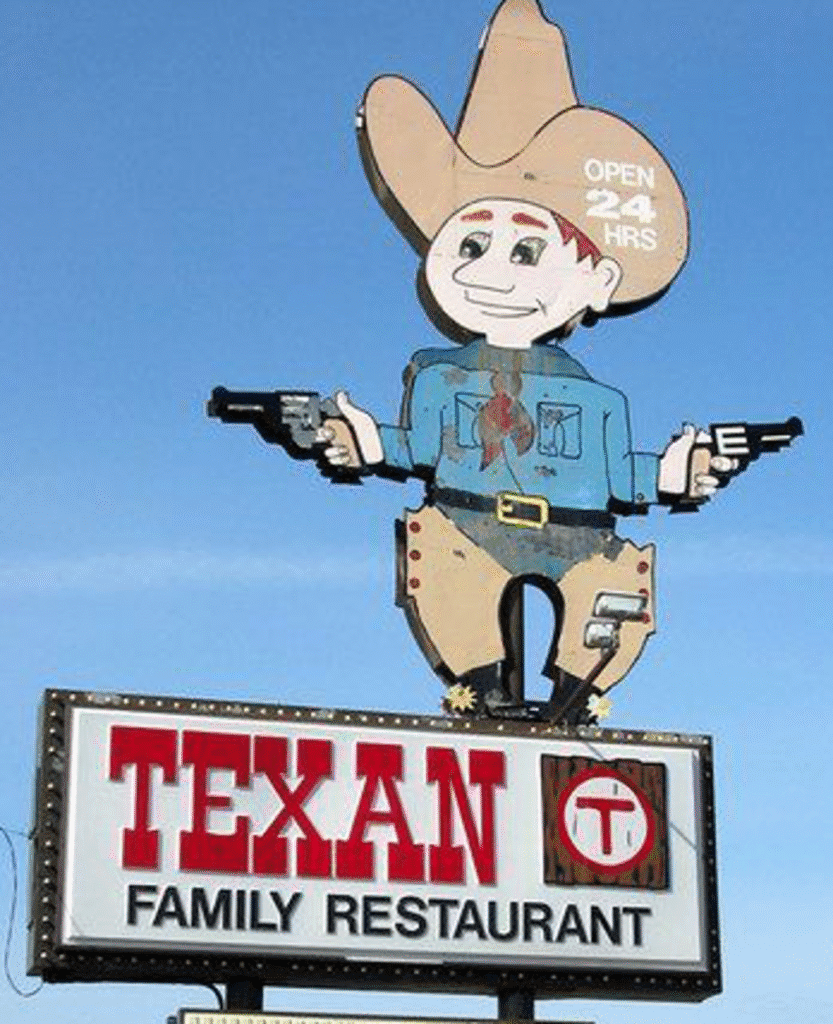
For night owls in the Saginaw Bay area, Texan Family Restaurant was the 24-hour fallback. The sign featured a baby-faced cowboy with a gun and a huge hat, a look that would never survive a modern branding meeting.
Texan served big breakfasts, steak sandwiches, burgers, Mexican plates, chili, and a dessert lineup locals still miss. The breakfast buffet and banana splits earned a loyal late-night crowd — especially after the bars closed.
The last Texan Family Restaurant, in Saginaw’s Westwood Shopping Center, shut down in July 2015, ending a 45-year run.
Here again, the chain didn’t collapse because people stopped liking eggs and hash browns. Ownership changes, thin margins, and competition from big national diners squeezed it out.
Stuckey’s: The Teal Roof That Wouldn’t Stay Dead

If your family hit the highways in the 1960s or 1970s, you knew Stuckey’s. Founded in Georgia in the 1930s, the teal-roofed gas station and snack shop grew to more than 350 locations by the 1970s, many tied to Interstates and busy U.S. highways used by Michigan travelers heading south.
Stuckey’s sold gas, souvenirs, pecan log rolls, and every form of sugary road food you could stuff into a back seat. After corporate ownership changes in the 1970s and 1980s, the chain shrank dramatically. Real estate became more valuable than the business itself, and many stores were sold off.
The family later re-acquired the brand and rebuilt it through a mix of licensed locations and a strong mail-order and retail business. Today, Stuckey’s lists more than 60 licensed stores around the country and makes most of its money selling pecan log rolls and nuts online and through partner retailers, not from full roadside stores.
It’s another example of how these defunct Michigan restaurant chains and their peers live on in unexpected ways. The sign may be gone from your exit, but the candy is still in the warehouse.
Howard Johnson’s: The Orange Roof That Marked the Exit
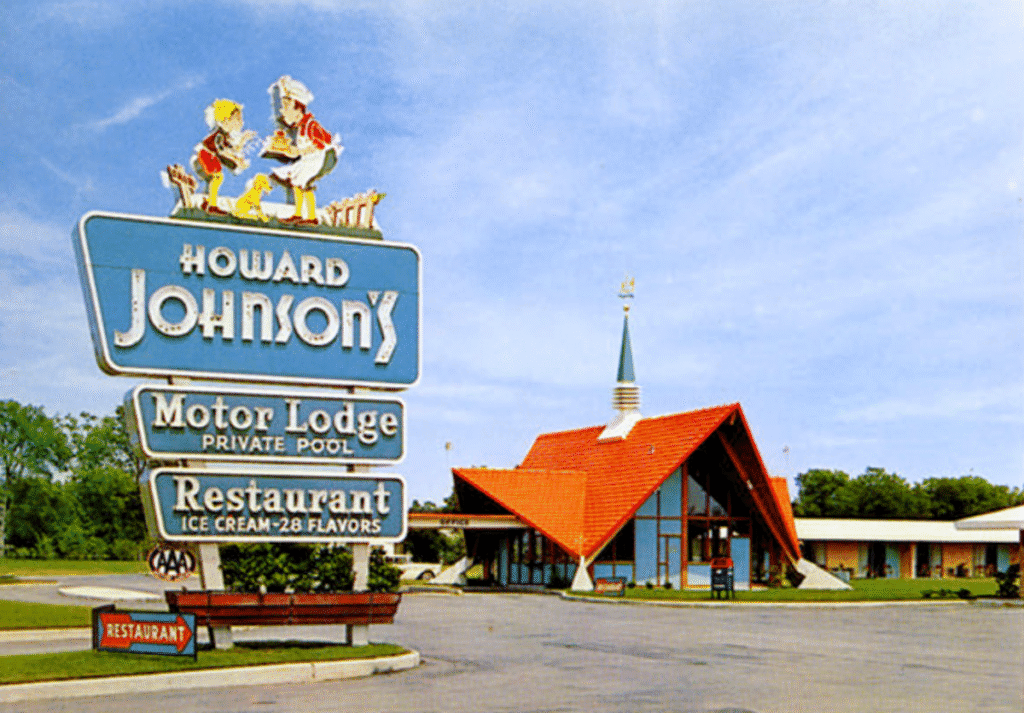
Howard Johnson’s started as a soda fountain in Massachusetts in 1925 and grew into America’s first major restaurant chain, with more than 1,000 restaurants and 500 motor lodges at its peak.
For Midwest families driving to Florida or the East Coast, the orange roof and the Simple Simon weathervane were a beacon. The promise: 28 flavors of ice cream, fried clam strips, macaroni and cheese, and consistent comfort food no matter which state you were in.
World War II almost killed the company, cutting locations from over a hundred to just a dozen along the East Coast. After the war, Howard Johnson’s bounced back by securing exclusive rights to run restaurants at many early turnpike service plazas.
The real trouble came later. New competitors, changing tastes, and corporate missteps hollowed out the chain. The last Howard Johnson’s restaurant in Lake George, New York, finally closed in 2022.
The hotels live on under a different owner, but the restaurants — and those fried clams — are gone.
Graph – The Highs and Lows of Our Favorite Defunct Michigan Restaurants
| Franchaise | High Point # of Stores | Today |
| Dog ‘n Suds | 650 | 11 |
| Bill Knapp’s | 60 | 0 |
| Burger Chef | 1050 | 0 |
| Ferrell’s Ice Cream Palor | 120 | 2 |
| Champs | 2 | 0 |
| Sveden House | 20 (est.) | 0 |
| Texan | 5 (est.) | 0 |
| Stuckey’s | 350 | 115 |
| Howard Johnson’s | 1,000 | 0 |
The Rise and Fall of Some of Our Favorite Restaurants.
What These Defunct Michigan Restaurants Still Tell Us
Line up these stories and you see a pattern. Most of these places didn’t die because the food suddenly got worse. They died when:
- New owners tried to “fix” what loyal customers already liked (Bill Knapp’s).
- Corporate parents chased short-term gains and stripped the brand to the bones (Stuckey’s and Howard Johnson’s).
- Debt and rising costs smothered chains that relied on thin margins and big dining rooms (Farrell’s, Sveden House).
The insight is that nostalgia and profit rarely move together. The meals people still talk about the most — the Pig Trough, the Dog n Suds coney, the Bill Knapp’s birthday cake — came from businesses that either failed outright or had to reinvent themselves in much smaller form.
Yet those memories still drive clicks, book sales, and freezer-aisle purchases. For a certain slice of Michigan, these closed Midwest family restaurants are gone, but they still shape how we judge every new chain that moves into the neighborhood.
Sources for Defunct Michigan Restaurants
“11 Bankrupt Restaurants We Would Love To See Again.” Thumbwind, 12 July 2023. 11 Bankrupt Restaurants We Would Love To See Again. Accessed 17 Nov. 2025.
“A Drive-In Down Memory Lane: Dog n Suds in Peoria.” Peoria Journal Star, 9 Dec. 2022. A Drive-In Down Memory Lane: Dog n Suds in Peoria. Accessed 17 Nov. 2025.
“A Tradition Born and Carried On in Jackson: Bill Knapp’s Cake.” 97.5 NOW FM, 29 Aug. 2021. A Tradition Born and Carried On in Jackson: Bill Knapp’s Cake. Accessed 17 Nov. 2025.
“Bill Knapp’s.” Wikipedia, Wikimedia Foundation, n.d. Bill Knapp’s. Accessed 17 Nov. 2025.
“Burger Chef.” Wikipedia, Wikimedia Foundation, n.d. Burger Chef. Accessed 17 Nov. 2025.
“Burger Chef’s History Brings a Smile to My Face, What About You?” Burger Beast, 16 Dec. 2020. Burger Chef’s History Brings a Smile to My Face, What About You?. Accessed 17 Nov. 2025.
“Champs! (1960s) Best Burgers Ever!! Two Locations: One on Dixie & One on M-59.” Facebook – Waterford, Michigan Nostalgia Group, n.d. Champs! (1960s) Best Burgers Ever!! Two Locations: One on Dixie & One on M-59. Accessed 17 Nov. 2025.
“Dog n Suds.” Wikipedia, Wikimedia Foundation, n.d. Dog n Suds. Accessed 17 Nov. 2025.
“Dog ’n Suds: Restaurants, Root Beer and History.” Burger Beast, 24 May 2019. Dog ’n Suds: Restaurants, Root Beer and History. Accessed 17 Nov. 2025.
“Farrell’s Ice Cream Parlour.” Wikipedia, Wikimedia Foundation, n.d. Farrell’s Ice Cream Parlour. Accessed 17 Nov. 2025.
Hill, Michael. “Requiem for a Clam Strip: Last 2 HoJo Restaurants Soldier On.” New Haven Register, 2 May 2015. Requiem for a Clam Strip: Last 2 HoJo Restaurants Soldier On. Accessed 17 Nov. 2025.
“Howard Johnson’s.” Wikipedia, Wikimedia Foundation, n.d. Howard Johnson’s. Accessed 17 Nov. 2025.
“No More Farrell’s Ice Cream Parlours in Michigan – or ANYwhere.” 99.1 WFMK, 6 Dec. 2019. No More Farrell’s Ice Cream Parlours in Michigan – or ANYwhere. Accessed 17 Nov. 2025.
Robinson, John. “Sveden House Smorgasbord – Why Did They All Close?” 99.1 WFMK, 6 Nov. 2019. Sveden House Smorgasbord – Why Did They All Close?. Accessed 17 Nov. 2025.
“Sveden House Smorgasbord Was a Buffet-Style ‘Serve Yourself’ Restaurant.” Texas Chronicles, Facebook, n.d. Sveden House Smorgasbord Was a Buffet-Style ‘Serve Yourself’ Restaurant. Accessed 17 Nov. 2025.
“Stuckey’s CEO Seeks to Overhaul Company.” Commercial Carrier Journal, 12 Aug. 2021. Stuckey’s CEO Seeks to Overhaul Company. Accessed 17 Nov. 2025.
“Stuckey’s, a Texas Road-Trip Icon Turned ‘Ghost Store,’ Sees Revival under Founder’s Granddaughter.” Houston Chronicle, 6 June 2022. Stuckey’s, a Texas Road-Trip Icon Turned ‘Ghost Store,’ Sees Revival under Founder’s Granddaughter. Accessed 17 Nov. 2025.
Stuckey, Stephanie. “Reviving Road Trip Nostalgia (and Pecan Log Rolls).” Stuckey’s, 13 June 2021. Reviving Road Trip Nostalgia (and Pecan Log Rolls). Accessed 17 Nov. 2025.
“Texan Family Restaurant Owners Turn Off Their Stove.” Township View, 30 July 2015. Texan Family Restaurant Owners Turn Off Their Stove. Accessed 17 Nov. 2025.
“This Defunct Restaurant Chain With Michigan Roots Still Sells Its Iconic Baked Goods Online.” Tasting Table, 23 Oct. 2025. This Defunct Restaurant Chain With Michigan Roots Still Sells Its Iconic Baked Goods Online. Accessed 17 Nov. 2025.


